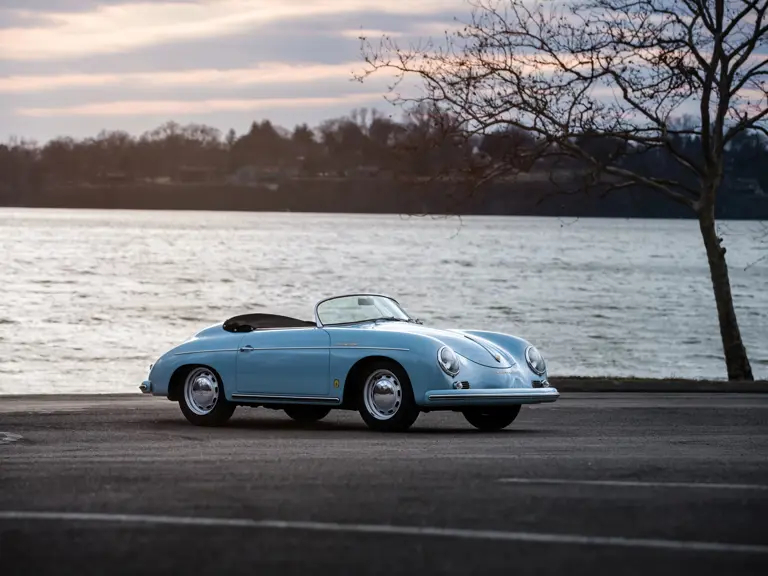
1958 Porsche 356 A Speedster by Reutter
{{lr.item.text}}
$260,000 - $275,000 USD | Not Sold
{{bidding.lot.reserveStatusFormatted}}
- Flat four-cylinder 912 engine "dressed to 356 style"
- #741 356B or C four-speed manual transmission
- "California car with original floorpans"
- Restored in original color combination
- Porsche Certificate of Authenticity
- Recent freshening and detailing
- Uncommon with limited production
It is difficult to explain the fascination that the Porsche name evokes. From the beginning, Porsche has captured the imagination and admiration of motoring enthusiasts the world over. From the standpoint of revolutionary technical innovations to its design elements, the Porsche is a masterpiece of its creator. Few cars of this era could match Porsche’s brilliant engineering and heritage. This represented a car whose performance was refined and improved through experience from over 7,000 victories (through 1958) in the world’s various races and rallies. Porsche’s limited production allowed the use of methods perfected by master European craftsmen, resulting in a car with personality. The Porsche 356A 1600 Speedster is a performance-proven car with classically timeless beauty refined down to the last detail.
Through the influence and persistence of legendary European automobile importer Max Hoffman, the iconic Porsche 356 Speedster hit the American roads in 1954, forever changing the Porsche brand both in the United States and around the world. Hoffman knew the U.S. market well and knew that the sub $3,000, minimalistic, racing-focused Speedster, was exactly what thousands of customers craved and desired. Compared to the 356A Coupe, the Speedster was 200 pounds lighter, and one second faster to 60-mph. Unlike the luxurious 356 Cabriolet, with its fixed windshield and numerous comfort features, the Speedster was very basic, with side curtains instead of roll-up door glass, a removable windshield, ventilated thin-shell non-reclining bucket seats, and little else. According to sources, 4,147 left the factory and were produced through 1959.
In late 1957, improvements were made to the Speedster model, including a larger rear window, 1,600-cc engine, exhaust exiting through the rear bumpers, a high bow canvas top, teardrop taillights, improved carburetion and ZF steering gear. Known specifically as the T2 variant, this marked the final production run of the Speedster prior to the Convertible D of 1959. By the time T2 (“Technical Program II”) Speedster production wound down in 1958, less than 1,200 examples are reported to have been built, and that group is considered to be the most modern and drivable today.
The car being offered is stated as a “California car with original floorpans” and has been subsequently restored. The rocker panels were replaced due to a “large dent.” We are informed that this 1958 356A Speedster has a “912 engine dressed to 356 style” and is more powerful than the original unit. This is paired up with a 741 manual four-speed transmission that is specified as a “356B or C” unit and upgraded 356 disc brakes all-around with dual master cylinder. The correct carburetors were refinished by Carb Rescue and the correct 356 generator has been refinished and rebuilt as well.
The restoration was started in the early 2000s with paint, interior and mechanical restoration. The Speedster was then driven from 2002 to 2007 when the engine came out shortly after for cleaning and detailing. The project was revived and then completed in early 2016 when the engine was reinstalled with detailing, plating and paint freshened with the correct components and hardware.
The Porsche 356A Speedster is presented in the same color combination that is recorded on its accompanying Porsche Certificate of Authenticity; Meissen Blue over Red Leatherette. This car shows a production completion date of November 6, 1957 and was finished with sealed beam headlights and U.S.-spec bumpers. Factory oil pressure and amp gauges are also installed. A tonneau cover, factory steel wheels and hubcaps are among the few appointments inherent with a Speedster. The Porsche has recently had interior detailing, touch-up cleaning, mechanical checks on all systems, as well as the electronics to provide a solid driving platform.
It was a true dual-purpose sports car. Owners could readily use their Speedsters for every-day transportation and then drive to the track on weekends, remove the bumpers, top, windshield, floor mats, and other trim, tape on some numbers and go racing. Speedsters offered excellent performance due to their light weight, and they soon established themselves as the cars to beat. They were well-built, reliable, and great fun to race. Speedsters remained competitive well into the 1970s and 1980s, winning many national championships in the U.S. and Europe.


 | Fort Lauderdale, Florida
| Fort Lauderdale, Florida


